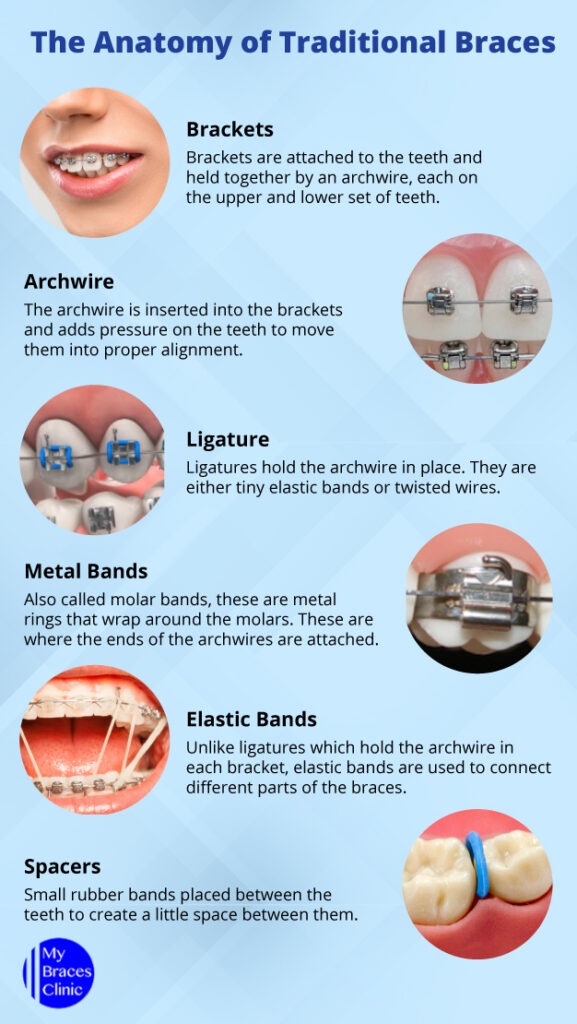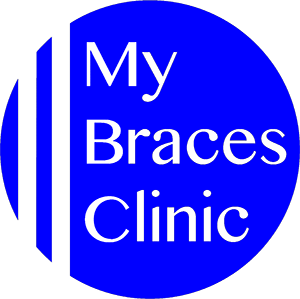Introduction

Are Braces For You? Your Complete Guide to Getting Braces in Singapore
Dental braces have been around for over 40 years and are proven to help patients develop healthy smiles.
Although braces treatment can be long and intimidating, it offers a permanent solution for straightening your teeth and helps you to feel more confident about yourself. In addition, it delivers long-term health benefits such as improving oral hygiene and reducing the risks of breaking, chipping, or cracking by making it easier to clean the teeth and evenly spreading biting pressure. In this guide, we share all the things you have to know about braces treatment in Singapore.
Part I: How Do Dental Braces in Singapore Work?
Traditional braces have metal brackets that run along a wire and are affixed to the teeth. As the braces apply pressure on the teeth, the bones that support the teeth gradually change, allowing the teeth to be shifted into an ideal position.
Today’s braces are made using many different materials, including ceramic which is less visible than metal. With the advancements in technology, there are also other alternatives to traditional braces such as removable invisible aligners and self-ligating braces. Invisalign® and Damon Self-Ligating Braces are at the forefront of these treatments, respectively. Lingual braces are another type of treatment available in Singapore today; they use the same brackets and wires as traditional metal braces, but are fixed to the back of the teeth instead of the front. At MyBracesClinic, we offer Incognito™ Lingual Braces that use the latest in CAD-CAM technology to ensure the slimmest precision fit, comfort, and accuracy.

Four Types of Braces
Metal Braces
Traditional metal braces work by attaching metal brackets to the teeth, with an archwire connecting the brackets. Adjustments are made by the orthodontist every two to three weeks so as to gradually shift the teeth into the proper position. These braces are desired for their affordability, but they are also highly visible due to their various metal attachments and colourful rubber bands.
Ceramic Braces
Ceramic braces work using the same mechanics as traditional or self-ligating metal braces, in which brackets have spring-loaded gates to hold the archwire and encourage the teeth to shift more naturally into place. However, as ceramic brackets are clear or tooth-coloured, ceramic braces offer an invisible advantage compared to metal braces.
Invisible Braces
Invisible braces are removable clear plastic aligners that are worn over the teeth. Patients are given several clear aligners to take home, and are to wear a prescribed set of new aligners every two to three weeks – in order to shift the teeth into position. Whilst the aligners are removable, patients are advised to wear them 22 hours a day for the greatest effectiveness. Some potential downsides to invisible aligners are that they are prone to staining and warping.
Lingual Braces
Lingual braces are affixed behind the teeth, making them completely invisible unless the mouth is opened wide. As such, they are ideal for older students or working adults that want a subtle treatment option. However, these braces are also more expensive and can be more difficult to clean. Adjustments in lingual braces can also take longer or be more challenging as the braces pull the teeth in instead of pushing them back.

Which Type of Braces Are The Best?
There are factors at play in determining the right braces for you:
- Aesthetics
- Budget
- Complexity
Should you prioritise an invisible braces look, ceramic, lingual and Invisalign clear aligners are possible treatment choices for you. However, you should keep in mind that these options are often more expensive due to the materials used as well as the technology and time required to customise these braces.
Besides aesthetics and price, the complexity of your teeth or jaw condition also determines the type of braces treatment that is most ideal for you. For instance, patients with severe teeth misalignment may not be able to use clear aligners for treatment but be advised to go with traditional metal braces instead.
What Dental Problems Do Braces Address?
Proper alignment of the teeth may not only improve the appearance of your teeth but as well as the overall health of your mouth, the way you bite and speak. It offers corrective treatment for the following dental issues:

When Should You Get Braces?
There’s no set age for getting braces. Some patients undergo treatment between 12-14 years old, around the time when all the baby teeth have fallen off and are replaced by a complete set of adult teeth.
Even adults can get treatment for crooked teeth or misaligned jaws. But, as far as the orthodontists in Singapore are concerned, you should go for a proper checkup as early as possible to detect and correct dental problems while in their early stages. It should help you avoid bigger and more expensive problems down the line.
Visiting the orthodontist doesn’t mean you will get braces immediately. This is particularly true for kids. But, an early assessment may give the orthodontist a better chance to guide the jaw growth and the eruption of permanent teeth, which in return offers the following benefits:
- Prevent narrower jaw, thus removing the chances of crowding
- Lower risks of teeth damage by properly aligning the protruding teeth
- Reduce risks of tooth decay and gum disease
- Correct bad dental habits (e.g. thumb-sucking, chewing non-food items, etc.)
- Improve overall appearance
Part II: What to Expect When Getting Braces
Getting braces is generally a safe procedure. But, regardless of the type of braces that you prefer, discipline and good oral hygiene are necessary to guarantee the success of the treatment.
Initial Assessment
At your first visit, your orthodontist will examine your teeth, mouth, and jaw. They may also ask you to bite your teeth together and ask questions whether you have problems speaking, chewing, or swallowing.
They may also take x-rays of your mouth to see how your teeth are positioned and whether there is a wisdom tooth or any permanent teeth that have yet to come in.
Preparation
As part of the preparation, your orthodontist may have to extract decaying teeth, remove impacted teeth, or treat a cavity by removing the decayed portion of the tooth and filling the area with dental fillings. They may also make an impression of your teeth to create a replica.
If your teeth are too close together, they may also put spacers between them at least a week before your braces are installed. They are usually rubber, but they can be metal as well.
Installation
Prior to the installation of braces, your orthodontist will clean your teeth with a solution that tastes a little sour. They will wash this off and for traditional braces, they will then glue the brackets to the centre front of each tooth and set the glue with the blue light.
Your orthodontist will then connect the brackets with an archwire and attach each end of the wire to the metal bands around the molars. As a final step, they will set the braces firmly in place by wrapping a small rubber band—called ligature—around each bracket and snipping the end of the archwire to make sure it doesn’t touch your gums or the back of your mouth. The fun part here is that you get to select the colour of the bands that you want.

Are Braces Painful?
Short answer? Yes. The pressure of the braces slowly pulling your teeth into alignment is what’s creating this pain. But, keep in mind that this pain is mild. You would feel the worst within a few hours after installation or after you have the wires adjusted but even that is manageable like a mild headache or a scraped knee.
This pain could last anywhere from a day to a week. In addition to that, you should expect the following during your first week of wearing braces:
- Sore gums and teeth, particularly when eating.
- Scrapes or sores on the inside of the cheeks.
- Potential cuts on the tongue as you try to feel the braces with your tongue.
How Much Do Braces Cost?
The cost of braces in Singapore varies significantly, but a good ballpark figure would be between $3,000 and $7,000. Some clinics can charge as much as $11,000 and it is understandable, given that orthodontic treatment is highly personalised and custom made to fit the patient’s dental situation. Plus, service charges can differ from one dental clinic to another.
Let’s look further into the factors that determine the brace prices in Singapore:
- Type of Braces
Whether you’re getting traditional braces or invisible braces can largely impact the cost of your orthodontic treatment. As discussed earlier, the less visible the braces are, the more expensive they can be.
- Choice of Orthodontic Clinic
According to the Singapore Dental Council, any registered dentist can provide orthodontic treatment. It means you can see a general dentist or an orthodontist to get your braces. However, their levels of expertise vary and so do their professional fees.
- Age
As you age, your teeth get a little more difficult to manoeuvre. Therefore, the treatment would take a little longer and quite more expensive than it would when you get braces when you’re younger. However, the difference is very minimal—$100 on average.
- Complexity of the Case
Apart from all these, the complexity of the case or the degree of correction required also affects the price of braces. Sometimes, orthodontists have to perform other related treatments like tooth extraction and dental fillings.
Whereas the total cost for braces can range between $3,000 and $7,000 without insurance, most orthodontists will provide instalment plans to make the treatment more affordable. The number of monthly payments will depend on the type of braces you prefer as well as the length of time that you will wear braces.

So, How Long Will You Wear Braces?
While we’re at it, it pays to know that most braces are worn for an average of two years. But, it remains largely dependent on the type of braces you use as well as how intensive the treatment is.
You will also have to factor in how well your oral hygiene and habits are to support your treatment. These include your discipline to undergo monthly adjustments and avoid foods that can help prevent issues like damaged brackets.
It goes to show that while there’s little you can do about your misaligned teeth, the progress you make during the treatment is dependent on your active participation. Even when you’re done wearing your braces, you still have to wear your retainers for another 6-12 months. It’s because your teeth still have the tendency to move after your braces are removed and retainers can help keep them in place.
Part III: Oral Hygiene & Braces Care Tips
Looking after your teeth when wearing braces starts with avoiding anything that can risk damaging your teeth and braces. These include sugary and starchy foods that can lead to plaque buildup and tooth decay as well as crunchy foods that may cause your brace wires to snap and your brackets to dislodge.
In conclusion, below is a rundown of the things you can do to take care of your dental health:
Braces Care Tips
- Cut down on foods that are high in sugar and starch, which can contribute to plaque buildup and tooth decay.
- Brush properly, preferably after every meal, and floss between braces and under the wires. You can use a floss threader to navigate your floss.
- Follow your orthodontist’s instructions—these include the amount of time that you have to brush your teeth, using fluoride toothpaste, and visiting your orthodontist for regular checkups, cleaning, and adjustments.
Foods to Avoid When Wearing Braces
In addition to the sugary and starchy foods, eating hard, crunchy foods are also discouraged as it can cause the brackets to dislodge from the teeth. Some examples of hard foods include popcorn, nuts, pretzels, hard candies, ice, raw carrots, and whole apples.
If you wish to eat carrots or apples, you would want to cook them or slice them into smaller pieces, respectively.
Meanwhile, your orthodontist will also advise you to cut down on sticky foods like chewing gums, marshmallows, jelly beans, liquorice candy, caramel, etc for the same reason that they can dislodge your brackets, bands, and wires.

How to Maintain Oral Hygiene When Wearing Braces
- Brush your teeth for at least three minutes, three times a day. It takes time to reach all areas of your mouth as well as remove any plaque and food particles. So, don’t rush through brushing your teeth to maintain a healthy set of teeth.
- Floss at least once every day. With braces, you can use a floss threader to help get your floss in between your teeth. This is an important part of your dental hygiene as it ensures no food is stuck in your mouth.
- Pay extra attention to the chewing surfaces of your teeth. The same goes for all the sides of your teeth, brushing in a gentle circular, back, and forth motion. Repeat these on the inside surfaces of your mouth.
- Use fluoride toothpaste. Most orthodontists recommend using fluoride toothpaste to prevent tooth decay. You may also use a fluoride mouthwash to provide further protection against cavities.
Dental Braces by MyBracesClinic
At MyBracesClinic, we offer a wide range of orthodontic services in Singapore to help you achieve the best and desirable smile that suits you and your child perfectly. These include Invisalign braces, lingual braces, ceramic braces, and braces customised for your kids.
We also provide dental diagnosis and treatment for various dental-related disorders including jaw surgery, sleep apnoea, and other solutions for teeth and jaw problems.
Aside from the health benefits, there are many aesthetic benefits to having perfect, straight teeth: it makes someone look more youthful, more professional, healthier, and physically attractive. It’s one reason that it’s almost mandatory for celebrities to flash a set of straight, white teeth and with dental braces, you can look like one!
We have a team of professional orthodontists and clinicians in Singapore who work together to continuously invest in technology, skills, and expertise to deliver satisfying results.
Invest in a perfect smile today! Visit MyBracesClinic to get started.



